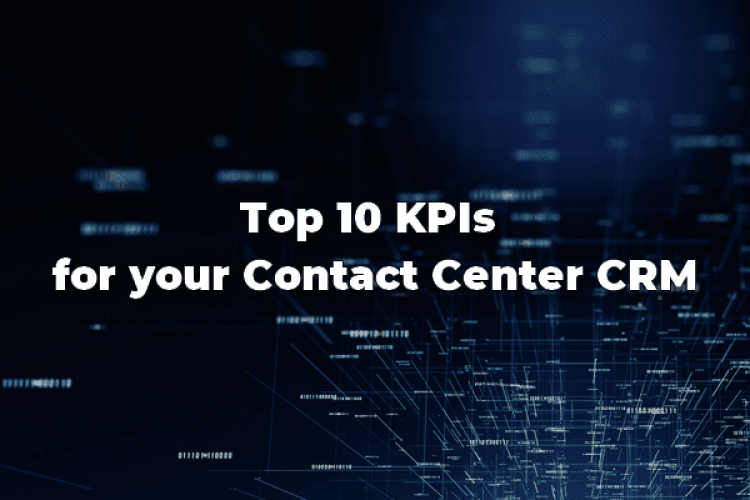KPIs are beneficial for all of a company’s business areas. They serve as the foundation for monitoring your activities, analyzing your position in comparison to the competition, and most importantly identifying areas for improvement.
CRM (Customer Relationship Management) software is intended to assist you in managing your remote customer interactions more effectively. Managing entails not only establishing customer relations activities, but also monitoring their effectiveness, impact, efficiency, and profitability. To enhance customer connections, you must adopt a steadfastly ROI-driven mentality. This entails creating a CRM report that incorporates critical performance metrics, functions and client data.
Here are 10 CRM key performance indicators that may be calculated and assessed using your data and contact center technologies. They are meant to assist your contact center in improving your CRM practice when combined with the KPIs that are unique to your business.
10 Key Performance Indicators (KPIs) for monitoring your Contact Centers’ CRM
Your customer relationship program and strategy raw material is the prospect and customer file. Before you can monitor the efficacy of your activities, you must first configure the indicators for monitoring the database’s performance. These performance indicators will assist you in addressing the following questions:
- How many consumers am I now serving?
- How much assets were lost throughout the course of the period?
- Have I accrued or depleted assets throughout the period?
- During the period, how many leads were activated and converted to customers?
1. Churn Rate
 Calculating the churn rate during a certain time period enables you to answer the following question: “What proportion of assets was lost over the timeframe? Alternatively stated: “What percentage of clients changed from active to inactive during the period under consideration? Additionally, this is occasionally referred to as the “attrition rate” or “passivation rate.” These are interchangeable words. The churn rate is used to calculate the percentage of active customers who leave between time t and time t+1.
Calculating the churn rate during a certain time period enables you to answer the following question: “What proportion of assets was lost over the timeframe? Alternatively stated: “What percentage of clients changed from active to inactive during the period under consideration? Additionally, this is occasionally referred to as the “attrition rate” or “passivation rate.” These are interchangeable words. The churn rate is used to calculate the percentage of active customers who leave between time t and time t+1.
Often, the reference time is a year or a month. It is calculated in the following formula: Number of active clients lost over time as a percentage of total customers. The churn rate is critical for determining the amount of client retention and your capacity to keep them.
2. Activation Rate
The activation of a lead is the process through which a lead becomes an active client upon their first transaction. The activation rate indicates the percentage of suspects, leads, and prospects in your CRM who convert to customers during a certain time period (month, quarter, year…). The activation rate is a highly important commercial metric for evaluating the effectiveness of your lead nurturing efforts (emailing, phone calls, prospect follow-up, etc.).
The following formula is used to determine the activation rate for a certain time period: leads activated / total number of leads. Additionally, you may determine the deactivation rate (= deactivated leads/total leads).
The term “lead” is used in these calculations in a broad meaning. It contains all contacts with whom you have initiated communication (or are about to do so). That is suspicious individuals, leads, and prospects.
3. Completion Rate
The CRM is the centralized interface that gathers all of your customer information. Your client database has various fields that you established upstream and which each relate to a different sort of information: last name, first name, address, email, telephone, gender, and age, for example. These data fields are also referred to as “attributes” or “variables.” The completeness rate is used to determine the rate at which fields for essential variables are completed. This is also referred to as the “fill rate” on occasion.
You may compute as many completion rates as there are fields in your CRM. The formula for determining the completion rate of a given field is rather straightforward:
The ratio of the number of customers for whom the field is filled in to the total number of customers in the database.
It is critical to fill the critical fields in your CRM in order to make it more exploitable. How are you going to do this? By directly soliciting information from your consumers or by acquiring third-party data.
4. The rate of net reactivity per communication channel
The net reactivity rate enables you to quantify the efficiency of your communication, channel by channel (telephone, email, mail…) and therefore to compare the performance of each channel.
For instance, if you wish to evaluate the performance of your SMS messages, the following computation yields the net reactivity rate.
The number of assets contacted through SMS and “converted” (across all SMS campaigns) / the total number of assets reached via SMS (all SMS campaigns combined). When an asset completes the action you desired by contacting them: subscribing to a new service, responding to the satisfaction survey, or clicking on the link to the landing page contained in the SMS, for example.
 A few factors should be included in your evaluation process to ensure a seamless and intelligent migration plan from a multichannel to Omnichannel contact center communication. From our First Contact Podcast series, Frank Wassenbergh, Cloudlinx’s CCaaS Practice Leader and Managing Partner, shares his knowledge towards a successful installation.
A few factors should be included in your evaluation process to ensure a seamless and intelligent migration plan from a multichannel to Omnichannel contact center communication. From our First Contact Podcast series, Frank Wassenbergh, Cloudlinx’s CCaaS Practice Leader and Managing Partner, shares his knowledge towards a successful installation.
5. Number of omnichannel contacts made during a given time period
The question is: how many did you send to your assets throughout the period, using all channels (phone, email, mail…) combined? To answer this question, you must sum up all contacts made via your various means of communication. This KPI enables you to assess commercial pressure on a globe scale.
There is no formula for this Rate. However, excessive soliciting might have a severe effect on your performance. You must strike the proper balance: send just enough solicitations to sustain and grow your assets’ interest in your brand without looking invasive or pushy.
6. Unsubscribe Rate
Churn rate is a metric that indicates the erosion of your client base as a result of your customer relationship initiatives.
The calculating formula is as follows: number of unsubscribed assets contacted / total number of contacted assets. A high churn rate is frequently the result of excessive commercial pressure. Measuring the pressure level is thus an important CRM KPI. However, the unsubscribe rate might be due to a variety of different factors (a lack of interest in your content and offers for example).
7. Revenues by time and asset
One technique to analyze your CRM’s business efficiency in your CRM reporting is to quantify the effect of your activities in terms of revenue income or, preferably, margins.
To be meaningful, measurement must be performed on an asset-by-asset basis (and over a given period). The calculation is as follows: income earned during the period and on assets solicited / total revenue generated during the time.
While business owners and leaders must consider their own goals when selecting the best technologies, having a good CRM is one of the cornerstones of high performances in contact centers. In that regard, check out our article on the “CRM Key Features For Customer Service”
8. Orders placed per time and asset
This is the response to the following question: on average, how many orders did the desired assets get over the period? To determine this, you must perform the following calculation: number of orders placed by assets contacted during the period / total number of assets contacted.
9. Rate of Engaged Customer Base
 Your CRM has two types of clients: active and inactive (or dormant) customers. Active customers are individuals who have interacted with you recently, most notably those who have made a purchase. Customers who are no longer responding to your solicitations and whose last order was “a long time ago” are considered inactive. How long ago is entirely dependent on your business, your industry, and the normal rhythm of your commercial relationship. The frequency with which headphones are purchased is not comparable to the frequency with which a car is purchased.
Your CRM has two types of clients: active and inactive (or dormant) customers. Active customers are individuals who have interacted with you recently, most notably those who have made a purchase. Customers who are no longer responding to your solicitations and whose last order was “a long time ago” are considered inactive. How long ago is entirely dependent on your business, your industry, and the normal rhythm of your commercial relationship. The frequency with which headphones are purchased is not comparable to the frequency with which a car is purchased.
From a CRM reporting perspective, it’s worthwhile to track the evolution of your active customer base over time, since they are the people that generate revenue and spread your brand image.
Additionally, you may compute and graph the active customer rate : number of active customers / total number of clients in your database.
 Everyone understands that the outbound Contact Rate has a direct and significant influence on the most critical outbound measure of all: the Conversion Rate. If your contact center is running outbound campaigns, you may learn Technology Tips, Tricks, and Solutions for a Dramatic Increase in Outbound Contact Rate. From our Webinar, “How to Increase Your Call Center’s Contact Rate?“
Everyone understands that the outbound Contact Rate has a direct and significant influence on the most critical outbound measure of all: the Conversion Rate. If your contact center is running outbound campaigns, you may learn Technology Tips, Tricks, and Solutions for a Dramatic Increase in Outbound Contact Rate. From our Webinar, “How to Increase Your Call Center’s Contact Rate?“
10. CRM global Return on Investment (ROI)
If you ask about the cost of a contact center’s technology, the owner will almost certainly have an answer. On the other hand, if you ask him how much money he makes from that technology, he is likely to be stumped. As a result, ROI plays a critical role in contact center solutions!
On the other hand; your CRM’s worldwide ROI (Return on Investment) enables you to determine its profitability. This business success indicator is produced by comparing two aggregates: the worldwide income generated by your CRM and the global costs and investments made in the tool, in human resources, in content, and in your campaigns. You may calculate the ROI of your CRM by using the following formula:
(the global income generated by your CRM / the global costs and investments in the tool, in human capital) x 100
This is also occasionally referred to as ROSE, or Return on Selling Expenses. The ROI (or ROSE) metric enables you to assess the relevance of your CRM strategy and the implementation’s excellence.
The Key Performance Indicators are essential but not all of them are vital
 A little point of discussion. When dealing with a large amount of data, it’s natural to expand the number of indicators to monitor. The increase is the nemesis of the good. Numerous reports are bloated with data, making it difficult to comprehend each of the signs offered.
A little point of discussion. When dealing with a large amount of data, it’s natural to expand the number of indicators to monitor. The increase is the nemesis of the good. Numerous reports are bloated with data, making it difficult to comprehend each of the signs offered.
The aim is not to utilize all 10 KPIs, but rather to utilize those that are pertinent to your contact center goals and CRM usage.
Developing meaningful reporting entails determining the optimal number of KPIs to display in order to maintain everyone’s attention. Bear in mind that these KPIs are only a means of determining what works and what does not and facilitating rapid decision-making. Take the time to exploit them, comprehend them, and use what you’ve learned in your approach.
In every case, KPIs are crucial steering tools and must be included in your contact center system. In that regard, NobelBiz is backed by years of expertise as a carrier and a provider of contact center software. We are the industry’s Promise Keepers, devoted to you the lowest per-minute prices, the highest contact rates, the best KPI efficiency, 24/7 support for your business, and a flawless experience for your customers.
Working with our cloud contact center solution NobelBiz Omni+ provides you with the following benefits:
- For your contact center, we provide world-class contact center software that is easy to use and provides exceptional customer service.
- A high-quality carrier-of-carriers network with competitive pricing for contact centers that wish to provide the best possible service to their clients.

Abdelmounim Benharouga has always had a strong passion for writing and digital marketing. He started as a Digital Content Writer part of marketing department then moved to being Customer Success Manager for the African Region within the Nobelbiz team.



